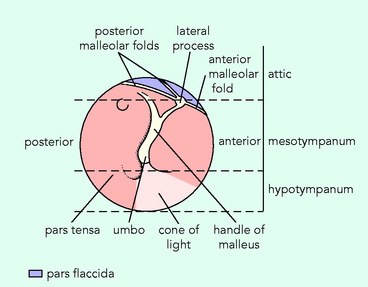Chapter 4 Ear, nose and throat
SYMPTOMS OF EAR DISEASES
Pain in the ear (otalgia)
Pain in the ear may arise from the ear itself (usually unilateral) but may arise from other sources.
Discharging ear (otorrhoea)
The ear naturally discharges wax which is a mixture of skin debris and apocrine gland secretion.
 Differential diagnosis: Otalgia
Differential diagnosis: Otalgia
| Pinna | Perichondritis, cellulitis |
| Neoplasm (basal cell or squamous cell) | |
| External canal | Furuncle, furunculosis |
| Otitis externa | |
| Impacted wax | |
| Foreign body | |
| Herpes zoster (Ramsay Hunt syndrome) | |
| Neoplasm | |
| Middle ear | Acute otitis media and its rare sequelae (mastoiditis, meningitis and cerebral abscess) |
| Secretory otitis media (glue ear) | |
| Eustachian tube obstruction | |
| Barotraumas | |
| Neoplasm | |
| Other sites | Teeth, tongue, pharynx (including tonsils and hypopharynx), sinuses, temporomandibular joint, cervical spine |
 Differential diagnosis: Discharging ear
Differential diagnosis: Discharging ear
| Site | Diagnosis |
|---|---|
| External ear | Otitis externa – bacterial, fungal or secondary to middle-ear discharge |
| Middle ear | Acute suppurative otitis media, chronic suppurative otitis media, mastoid disease (rare), neoplasm (rare) |
| Inner ear | Fracture (cerebrospinal fluid leak) |
Hearing loss (deafness)
Hearing loss is recognised as being either conductive or sensorineural.
CONDUCTIVE DEAFNESS
Conductive deafness is the term used to indicate that hearing is being impaired by a malfunction in the conduction and magnification of sound to the cochlea.
SENSORINEURAL DEAFNESS
 Differential diagnosis: Hearing loss
Differential diagnosis: Hearing loss
| Age group | Causes | Type of loss |
|---|---|---|
| Infants | Congenital | Conductive or sensorineural |
| Secretory otitis media (glue ear) | Conductive | |
| Young children | Congenital | Conductive or sensorineural |
| Secretory otitis media (glue ear) | Conductive | |
| Postinfective (meningitis, viral) | Sensorineural | |
| Adolescents | Congenital | Conductive or sensorineural |
| Malingering | — | |
| Postinfective (meningitis, viral) | Sensorineural | |
| Acoustic trauma or drugs | Sensorineural | |
| 20–40 years | Postinfective (meningitis, viral) | Sensorineural |
| Acoustic trauma or drugs | Sensorineural | |
| Otosclerosis | Conductive | |
| Acoustic neuroma | Sensorineural | |
| Ménière’s disease | Sensorineural | |
| Postoperative complications | Conductive or sensorineural | |
| 40–60 years | Acoustic trauma or drugs | Sensorineural |
| Otosclerosis | Conductive | |
| Acoustic neuroma | Sensorineural | |
| Ménière’s disease | Sensorineural | |
| Postoperative complications | Conductive or sensorineural | |
| 60+ years | Presbyacusis | Sensorineural |
| Acoustic trauma or drugs | Sensorineural | |
| Acoustic neuroma | Sensorineural | |
| Postoperative complications | Conductive or sensorineural |
Vertigo (dizziness)
Vertigo is a symptom of imagined spinning or unsteadiness. Patients feel they or their surroundings are moving. This is true vertigo and is caused by inner-ear vestibular dysfunction. Vertigo arising from the vestibular mechanism is known as peripheral vertigo.
EXAMINATION OF THE EAR
External ear
PINNA
Minor congenital abnormalities
Accessory auricles occur anterior to the tragus and are another embryonic fault.
EXTERNAL CANAL
The diameter of the canal is very variable and even in some adults may be very narrow. In a child the canal is straight and the tympanic membrane is easily seen. In adults the distal part of the canal, close to the tympanic membrane, narrows (the isthmus) in its final third and deflects downwards. This results in a recess inferiorly with an acute angle being formed between canal and tympanic membrane.
 Differential diagnosis: Cosmetic presentations
Differential diagnosis: Cosmetic presentations Red flag box – urgent referrral: Unilateral deafness or tinnitus
Red flag box – urgent referrral: Unilateral deafness or tinnitus Differential diagnosis: Central and peripheral vertigo
Differential diagnosis: Central and peripheral vertigo Review: Contraindications to syringing
Review: Contraindications to syringing



